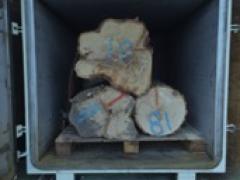by Henry Quesada. Virginia Tech.
State and federal agencies across the country are taking action on methyl bromide (MB) log fumigation operations. For example, in North Carolina environmental regulators are requiring all sites to capture and control 90% of the emissions with this chemical. In the case of Maryland, fumigation with MB has been banned since 2016 leaving exporters with no option but to go to neighboring states for fumigation services. The chemical has been banned in 150 countries and is only allowed in the US for a few uses, including log fumigation.
Methyl bromide is most often used as a gas fumigant against insects, termites, rodents, weeds, nematodes, and soil-borne diseases. The gas is considered an ozone depleting chemical and chronic exposures can cause health issues. Fumigation is a technique used to kill bugs and pest living in the wood. Logs are put in exporting containers and filled with MB gas for up to 72 hours. Sulfuryl Flouride and Phosphine are alternative fumigation methods to MB but they have higher environmental and health footprint than MB. An alternative to fumigation is log debarking that considerably reduces the changes of insects or pest to survive.

According to the USDA Animal and Plant Health Inspection Service (APHIS), there are three authorized treatment facilities in Virginia that use MB as a fumigation treatment: Casuron, Inc. (West Point), Royal Fumigation, Co. (Suffolk), and Western Fumigation, Co. (Suffolk). The log export industry in VA is concerned about the increasing pressures from environmental regulators. Virginia exported $31.9 million and $50.4 million in log exports in 2016 and 2017 respectively and about 67% of 2017 log exports went to China. Like many other countries, China requires that logs coming from the US are treated to make sure insects and pests are eliminated.
As a way to mitigate the problem and provide the industry with an alternative solution, Virginia Tech researchers lead by emeritus professor Dr. Mark White and senior research associate Dr. Zhangjing Cheng are working on a log treatment option using vacuum and steam technology. This solution does not required the use of chemicals and it could considerable decrease the treatment time when compare to current fumigation methods.

Figure 1. Oak logs infested with thousand canker and oak wilt disease
The research team at VT built a prototype chamber at Virginia Tech where untreated oak logs were tested. Results indicate that oak logs with diameters between 23 to 49 centimeters can be heat treated to 56 C for 30 minutes at the log center using saturated steam at 90 C and pressure of 100 mm Hg in 6.4 hours with an energy requirement of approximately 0.052 Kwh/kg of log mass.
These results are very promising as all insects and pest are killed using this treatment. In fact, Welker, a german company and Phytovac, a phytosanitation vacuum solutions company are partnering together with Virginia Tech to develop a commercial vacuum and steam solution. It is estimated that the initial investment for this solution would be around $800,000 per unit.
